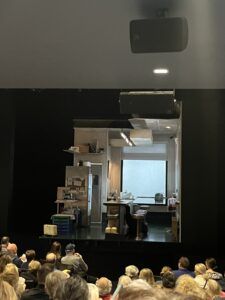On Sunday afternoon, I endured a traffic-filled trip into Manhattan to attend an Off-Broadway performance of The Counter at the Roundabout Theatre. I was unsure of what to expect from this play, as I had only previewed a short synopsis about its plot to get a general understanding about what I would be watching. I knew that it would be tackling heavy topics such as suicide, so I was prepared for this aspect. However, there were various characteristics of the show that surprised me.
When I took my seat in the theatre, I opened my Playbill to skim through it. I thought it was interesting that there were only three members of the cast that would be taking the stage. This contrasts my previous experience in attending theater productions because I am used to seeing large casts and ensembles perform with one another. I believe that the reason that the cast is so small is to help maintain the focus of the play. If there were more characters in the play, our protagonists, Paul and Katie, may not have been fully developed to the extent that they are at the conclusion of the show. Providing backstory and emphasizing the manner of interaction between these two characters is crucial to conveying the story as a whole, and thus would have been less impactful if overcomplicated with unnecessary side characters. It may be arguable that Peg is a side character, but it is evident that her role in the play was critical, for she was able to reveal aspects of Paul’s life to Katie that he would not have been willing to share otherwise. This allows us to contextualize his current state of mind to further understand his choices.
Another feature of the show that surprised me was its simplistic set design. I personally believe that set curators and designers can be considered artists because they are responsible for creating visuals that lend themselves to the story, without revealing too much information. At some shows that I have attended in the past, there are frequent or periodic changes in scenery. I thought it was interesting that the set remained the same for the duration of the play, and I feel that this is intentional so that the viewers understand that our characters are the ones moving the story along, rather than them being moved. I did enjoy how the lighting would change to represent night and morning, which would signify a new day.

I thought that the dialogue itself was emotional and at times difficult to listen to. Both Paul and Katie had endured troublesome events in their lives. However, Katie chooses to handle her trauma by running away from it and refusing to / putting off confronting it, when in reality that is an important step to healing. In my opinion, one of the most impactful moments of the show is when Katie reveals to Paul that she had to have surgery due to medical complications and can no longer have children. You can hear the frustration and anguish in the actress’s performance. I feel that this signified how we as people do not always know what others have experienced, as this was triggered by Paul saying that she does not know how to take care of someone. We also learn that Paul’s brother and mother passed away, and he feels that they were the only people who were capable of truly loving him. Both Katie and Paul’s hardships provoke strong emotion in viewers and help us to gain insight into their actions.
However, I still have some questions about the ending of the play. I find it difficult for me to decipher whether the conclusion of the show is intentionally open-ended, with the purpose of provoking thought within the audience, or if I just happened to miss something; admittedly, I zoned out a few times due to the show’s somewhat repetitive nature at times. I am hoping that it is the former. If inviting viewers to interpret the final scene in a way that makes sense to them was the playwright’s intended goal, I feel that they accomplished this. While I was watching in the moment, I was anticipating Paul to begin exhibiting signs of a stroke, as I had somehow assumed that Katie decided to poison his coffee that morning. This is largely due to the long embrace that the characters share just moments before Katie exits the cafe. It felt like a final goodbye, so I was under the impression that she may have known he would pass away in a short amount of time. However, this did not occur, but that is not to say that this could not have occurred after the final scene concluded. This may have to do with playing into the pessimistic / optimistic nature of viewers, as pessimists may be more inclined to assume that Paul’s life would shortly come to an end, while optimists may assume that this long goodbye signifies an end to Katie’s temporary solution of running away from her issues, as she leaves to meet up with her estranged friend/lover who she has been ignoring for two years. This epitomizes how this play, much like any art, is subjective, and can hold various meanings to different people depending on the general outlook on life, which can be impacted by both their lived experiences and the world around them.


